Musical Notes
Create successful practice, explore a composer's historical lifestyle, learn about modern composers, experience local performances - Musical Notes will enhance your music education and capture your imagination. Be Inspired!
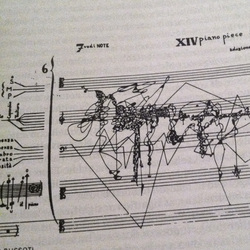 As a student, there were times when I was positively certain that the musical notes on my newest lesson pages decided to get up and move around the grand staff as I headed home after my piano lesson! When I sat down to practice, I just could not get that music to sound as good as it had at my teacher's house - it didn't even look the same. Do you ever feel that way? Here are some simple, but important steps, to remember as you begin to practice your new piano piece at home for the first time... Split your piano music into several sections. (No, I'm not suggesting that you tear up your music pages!) Try to find several different sections within the music. Perhaps you can learn it line by line. Or maybe the song easily divides into phrases. You can always ask your teacher for help if you're stuck! Learn each hand one at a time. For most of us, our hands need to learn to work together at the piano! Once each hand is comfortable playing it's part, then you can slowly put them together. Sing as you play! If you know the melody of the song you are trying to learn, don't be afraid to sing as you play. Singing will help you know if you're hitting the right notes and if you're using the correct rhythm. Don't try to play the entire piece at once. We all like to be able to sit down and play our piano piece successfully from beginning to end, but that's not usually possible with a new piano piece. So, don't get frustrated! Take those sections that we mentioned earlier, and learn them one by one - then, put them together one section at a time. It's like a puzzle! Okay, go and apply those ideas to your newest musical assignment! Join us again tomorrow, when we discuss more tips on learning a piano piece for the first time.
0 Comments
 With 250,000 lights, 47 miles of wire and over 10 tons of holiday decorations, the Symphony In Lights is a sight to behold! Little musicians will have fun noting how the lights blink to the beat of the music. And as the notes climb higher, so do the lights! Come see the Center Court at The Shops at Wiregrass be transformed to a winter wonderland - complete with snow flurries - and enjoy the music of the Trans Siberian Orchestra. Shows run on the hour (6-9pm) every evening until December 31st. Enjoy a musical evening and Christmas shopping with The Shops at Wiregrass in Wesley Chapel, FL. See a video of last year's performance here.  These homemade paper plate tambourines are an incredibly versatile craft. You can use plates that already sport a fun design, or plain white plates that can be colored or covered with tissue paper, stickers or sequins. Here's what you need: 2 Paper Plates (preferably heavy duty) Beans, Pasta or Rice (something to fill the inside) Stapler or Glue Hole Punch String, Yarn or Ribbon Jingle Bells (optional) Decorating Items - Crayons, Markers, Tissue Paper, Stickers, Sequins, etc. Place your filler inside one of the plates, and place the other plate over top - so that the inside of both plates are facing each other. Staple or glue both plates together. Using your decorations, make your tambourine colorful! If you're using jingle bells, you'll want to use your hole punch to put some holes around the edge, and than use string or ribbon to attach the bells. For some more fun decorating ideas visit this website. Put on some upbeat music and dance with your tambourine! How many different sounds can your new instrument make? What does the filling inside sound like? Maybe you'd like to make a couple tambourines with different things inside! Do the beans, rice or pasta all have different sounds? What types of sounds can you make with the jingle bells? 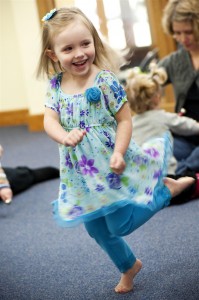 As the weather gets cooler, Kindermusik is a great source for indoor fun on a chilly day! Besides helping your little one exhaust his seemingly endless supply of energy, music and movement have been shown to increase learning and get the brain engaged. That being said, here are some excellent musical activities to incorporate into your day: Finger plays like the Insy Winsy Spider are great for tiny hands. The movement activates little fingers, and helps fine motor development. And a song about a spider - a perfectly fun topic for little minds! Our toddler music classes introduce a creative new finger play in each one of our Kindermusik Wiggle & Grow units. Free dancing along to music is an activity that most kiddos thoroughly enjoy - and if you add a favorite teddy bear, the fun grows! Your child is not only loosing some of that pent up energy, but she's also developing her brain by coming up with creative movement that goes along with the music she's listening too. For added inspiration, make sure your playlist has a variety of musical styles! Rocking and swaying to calming music can be wonderful ways to calm your little one and help him prepare for a nap or for bedtime. In fact, you may want to make it a regular part of your bedtime routine. Many of our weekly activities can be successfully enveloped into your daily routine at home. Whether you have a structure time for music and movement or you simply play music throughout the day, your child will benefit greatly from music in her life! If you haven't already, come join us for a free preview Kindermusik class! 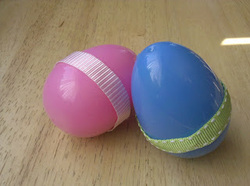 Make some colorful shakers with your left over plastic Easter eggs - next year! :) Materials: Plastic Easter Eggs (colorful or clear) Rice, Popcorn Kernels, or Colorful Sand Hot Glue Gun or Electrical Tape Ribbon (optional) Open each egg and fill halfway with your filling. If you're using a colorful egg, rice or popcorn kernels work great! If you have some clear eggs, you may want to consider using colorful sand. You can use the hot glue gun to glue the egg shut. If you want some extra color, then glue a small ribbon around where to two parts connect.  Now, if your children are like my boys, they will have the ribbon off and the egg opened as quickly as possible. A better option may be to use electrical tape to close your egg. Not only will it stretch around the egg and keep it closed, but it adds a ribbon of color - you may even be able to find some fun designs! These homemade instruments are the perfect size for little hands to gasp. Turn on the music and shake your eggs to the beat!  "Come on! Keep them rolling!" This call was overheard by Lieutenant (later Brigadier General) Edmund L. "Snitz" Gruber as he and his small detachment wound their way through the Zambales Mountains of the Philippines in 1907. About a year later, this simple command would inspire the original version (known as "The Caisson Song") of what we now know as "The Army Song." When senior artillery leaders were searching for an official marching song toward the end of World War I, "The Cassion Song" was passed on to John Philip Sousa. The noted composer produced a rousing version of Gruber's tune which quickly became a blockbuster record. But it wasn't until 1952, that "The Caisson Song" was adapted by H.W. Arberg and became the official song for the U.S. Army: "The Army Goes Rolling Along." For the full story from Soldier's Mag. Click Here. 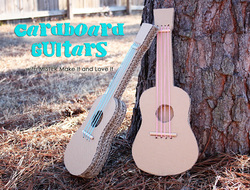 This week's idea comes from Make It & Love It blog. My little guys love to "play" the guitar, so I can't wait to give this project a try! You'll need several different materials - some you may find around your house, others you can find for free at your local grocery, office supply, or book store. A few you may need to buy. 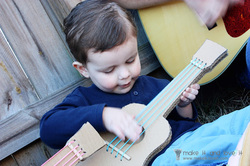 Materials: Pattern Templates found here Cardboard (used boxes work fine) Utility Knife Hot Glue Gun Four Large (7") Rubber Bands Two Paper Clips: 1" and 1-1/2" Wooden Pencil or Dowel For detailed instructions (complete with pictures), I'm going to send you on over to the Make It & Love It blog post: Cardboard Guitars. Have fun!  Did you know that toddler music classes can have an impact on early math development? Here are three benefits sited by Kindermusik International: Spatial awareness refers to an individual's ability to recognize himself in space - to be aware of the objects around him and his relationship to those objects. This type of reasoning seems to develop more quickly for children who are involved in music classes. Pattern recognition is another area where children can develop more quickly when involved in toddler music classes. And no wonder! Listening to music is a great workout for the brain! Our minds need to recognize and organize the rhythms and melodies to fully enjoy the music. And we take it a step further when we clap to a steady beat, dance along to the rhythm or use our instruments to play along! Counting by rote requires repetition. There are many songs in the Kindermusik curriculum that make the memorization of numbers fun. For example, in our Time for Lunch unit, your toddlers learn to count to eight as they sing One Potato, Two Potato while creating an imaginary pot of yummy soup! Music and math seem to go hand in hand - especially in the toddler music class. If you haven't already, contact us and schedule your free Kindermusik preview class!  When it comes to the week before the recital, most of the hard work should be completed. You're pieces are learned, and we're simply working to perfect the details and have fun as we tell as story with your music. So, how are you supposed to practice this week? Pretend that you're playing for the recital. Warm up a little bit, and then walk away from the piano. You can sit down and pretend that you're sitting in the audience waiting your turn! Walk up to the piano with your music (or without, if you're playing from memory), and sit down as you will at the recital. Make sure you take some time to adjust the piano bench. You need to be comfortable to play well! And then take a minute to look at your music and think about the first few measures of your music. Finally, begin to play! Remember, this performance is supposed to be just like playing for the recital. So, if you make a mistake, don't get flustered, keep going! After you've finished your first piece, take your hands off the keyboard and put them in your lap. Turn to your second piece, and once again, take a minute to think through the first couple measures of your music. Play your second piece! Once you've finished, place your hands in your lap. Then stand and face the audience. Imagine the applause as you take a bow! Have a Practice Recital for your Family Gather your family for a practice recital! It's even a great idea to wear the clothes you will wear for the recital (especially your shoes if you'll be using the damper pedal). |
Jessica's Piano Studio
Jessica B.
Teacher at Jessica's Piano Studio to many talented students! Here's some helpful tips and interesting information to create a wonderfully educational musical experience! Archives
March 2015
Categories
All
|